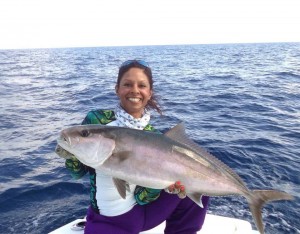10 Saltwater Fish Species to Catch by Boat
By Debbie Hanson
Jul 28, 2014
While there are many fish species that can easily be caught while fishing from the shore or a fishing pier, there are also several that you wouldn’t have much of a chance at catching unless you were fishing offshore from a boat.
While there are many fish species that can easily be caught while fishing from the shore or a fishing pier, there are also several that you wouldn’t have much of a chance at catching unless you were fishing offshore from a boat.
Here is a list of 10 saltwater species that are typically found offshore or in ocean waters at depths of 50 feet or more. You can find out where in the U.S. these species can be caught by looking at the distribution map to the right of the illustrations on the Species Explorer pages.

-
Greater Amberjack — The greater amberjack are an offshore species, most commonly found off the coast of the Southeastern U.S. in 60 to 240 feet of water near rocky reefs or wrecks.
-
Dolphinfish or Mahi Mahi — The dolphinfish, also known as mahi mahi, can be found worldwide in tropical and warm temperate ocean waters. Dolphinfish are a pelagic and migratory species. Though they can be occasionally caught from a saltwater pier, they are predominantly a deep-water species that inhabits the surface of the open ocean.
-
Black Marlin — The black marlin is a pelagic fish that inhabits the tropical Indian and Pacific Ocean waters. In the U.S., they have been caught off the coast of Southern California. Because of the black marlin's size and strength, they are a highly sought after sport fish species.
-
Blue Marlin — This pelagic and migratory species occurs in tropical and warm temperate oceanic waters of the Atlantic and the Pacific. It is less abundant in the eastern portions of both oceans. Recreational anglers often make trips to the Florida Keys or California to fish offshore for blue marlin.
-
Striped Marlin — Found in the tropical and warm temperate waters of the Indian and Pacific oceans, the striped marlin is pelagic and migratory, moving toward the equator during the cold season and away again during the warm season. They are often caught from charter sport fishing boats off the coast of Southern California.
-
Swordfish — The swordfish can be found worldwide in temperate and tropical oceanic and continental shelf waters from the surface to depths of 2,400 to 3000 feet or more. The U.S. has implemented a number of management measures to protect undersized swordfish and allow the population to rebuild.
-
Bigeye Tuna — The bigeye tuna inhabits the warm temperate waters of the Atlantic, Pacific, and Indian Oceans. The bigeye tuna is a pelagic, seasonally migratory species. Schools of bigeye tuna generally run deep during the day whereas other species of tuna are known to stay near the surface.
-
Bluefin Tuna — Bluefin tuna are found in the subtropical and temperate waters of the North Atlantic Ocean and in the Mediterranean and Black Seas. Bluefin are a pelagic, schooling, and highly migratory species. The migration of the bluefin tuna is known to be the most extensive of all fish species and is tied to water temperature, spawning habits, and the movements of baitfish species upon which they feed.
-
Yellowfin Tuna — Known to be the most colorful of all tunas, the yellowfin occurs worldwide in deep, warm temperate oceanic waters. It is both pelagic and seasonally migratory, but has been known to come fairly close to come to shore.
- Wahoo — Wahoo are found worldwide in tropical and temperate seas. They are most often caught off the coast of the Southeastern U.S. in states such as Louisiana and Florida. The wahoo is pelagic, migratory, and travels either solo or in small groups of two to six fish.

Did you notice that the majority of these species have one thing in common? They are all pelagic fish with the exception of the greater amberjack. If you're wondering what the term "pelagic" means, read my earlier post titled, "9 Weird Fishing Terms and What They Mean" to find out.









